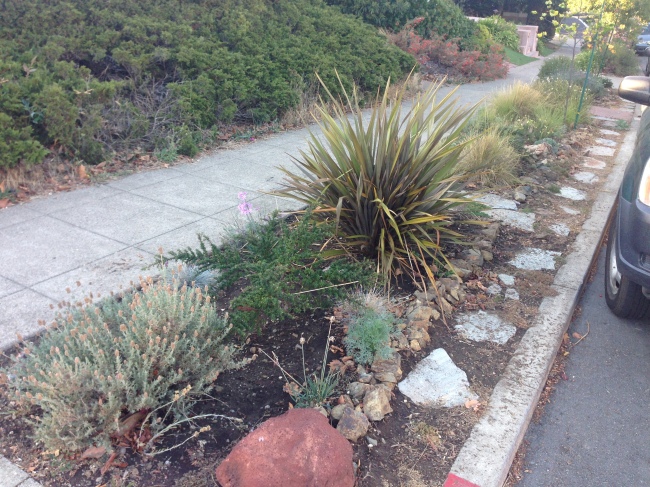I was just at our neighborhood block party and met many people I didn’t know- but they knew me because they’d seen me out in my front yard tending my tiny pollinator garden. They commented on how beautiful it is, and one even asked if I could help her with her landscaping. It’s amazing how creating habitat for bees also serves as a way to connect with my local community.
Planting your own lovely pollinator garden is really satisfying and simple: A new study in the UK shows that planting your garden with pollinator-friendly flowering plants is easy and inexpensive. Plus some of the plants are common herbs that add to your culinary endeavors, including marjoram and lavender. Rosemary is another plant typical to urban landscaping that is highly attractive to bees. For the full story on BBC news, click here.
Last summer my husband and I planted native flowering plants along the “parking strip” in front of our house (the area between the side walk and the street). The area was just grass and weeds, which we pulled- then we turned the soil and amended it with gypsum (it has a lot of clay) and compost. To gather the plants, we went to the UC Botanic Garden sale, to the local California Native Plant Society Nursery, and to a neighborhood nursery, Westbrae. You can see the initial stages in the photo below. We enlisted a friend to help and got some nice pavers to make a walkway during a sale at a local hardware store.
A little over a year later we have a colorful array of sages (salvias), buckwheat, native grasses including blue fescue, yarrow, and california lilac (ceanothus). We also added some succulents, which are classic xeroscape plants, and some non-natives from other Mediterranean regions including lavender and New Zealand flax. The city of Albany has a program where they cost-share the price of planting trees in parking strips, so we had them plant a red bud (though sadly they would only let us plant the eastern variety, not the native western species). I’m also considering getting 2 more plants to put in this winter: milkweed, which is loved by bees and butterflies alike, and phacelia, a california native plant with purple or while flowers that stick up like a scorpion tail and are bumble bees absolute favorite.
If you want to encourage bee nesting, it’s important to leave bare soil. We decided not to mulch for weed suppression, though we do weed every 2 months or so. To fill in the spaces with bee-attractive blooms while leaving bare dirt, we collected a few poppy seeds from a nearby plant, and had dozens of poppies filling in the gaps this past spring and summer. We just bought a wildflower mix that we’ll sprinkle onto plot once the rains come- so next spring our front yard should be a pollinator paradise.
When it’s really hot out we water about once a week- but most of the CA natives are drought tolerant and low maintenance. After they establish, we shouldn’t have to water too much at all. The best time of year to plant is now- so the rains provide the moisture the plants need to put down their roots and thrive come spring.
For more ideas on plants that attract pollinators check out the Xerces Society book Attracting Native Pollinators and the informative urban bee website helpabee. The UC Agricultural Experiment Station just published a guide on plant selection in California as well. With this wealth of resources, it will be easy to make your garden a pollinator refuge.


